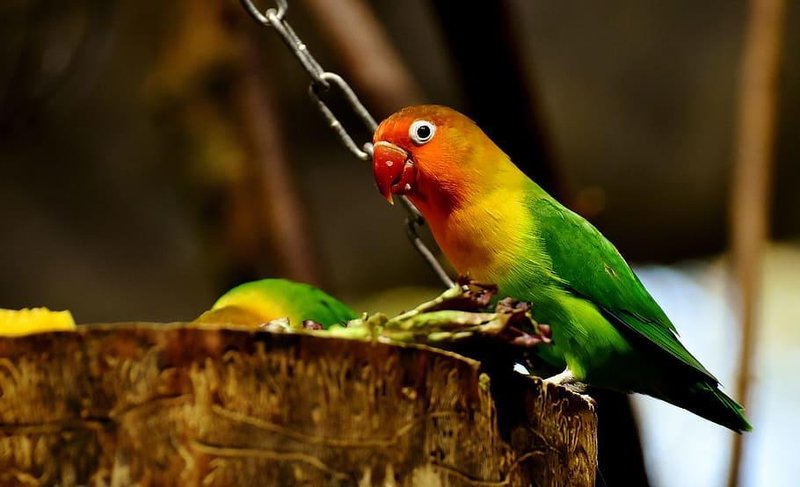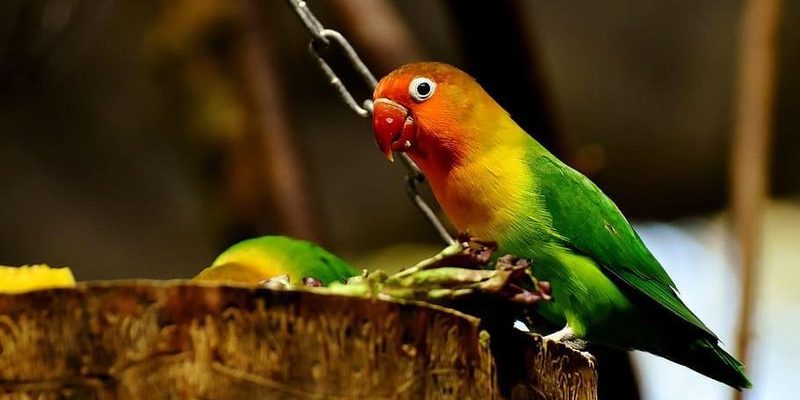
Lovebirds, particularly species like the Peach-faced Lovebird found in Africa, have a varied diet that consists mainly of seeds, fruits, and vegetables. Imagine them as tiny chefs, mixing different ingredients to create a healthy plate—only this plate is made up of seeds, chopped veggies, and colorful fruits. They forage in the wild, using their sharp beaks to crack open seeds or nibble on leaves. This natural behavior not only keeps them fed but also helps to maintain their beak strength and agility. Now, let’s explore what exactly these little bundles of joy love to munch on—and how they go about finding their food.
What Do Lovebirds Eat?
Lovebirds primarily feed on a diet rich in seeds, fruits, and vegetables. In the wild, they typically munch on seeds from grasses, grains, and various other plants. Here’s a closer look at their staple foods:
- Seeds: Lovebirds enjoy a variety of seeds, including millet, sunflower, and canary seeds. These tiny energy boosters are essential for their diet.
- Fruits: Fresh fruits like apples, pears, and berries are favorites. They love the sweetness and moisture, which provides hydration.
- Vegetables: Leafy greens such as spinach, kale, and broccoli are excellent for their overall health—packed with vitamins and minerals.
You might be wondering how these ingredients benefit lovebirds. The seeds give them the energy they need to fly and play, while fruits and vegetables help with hydration and provide essential nutrients. Honestly, a balanced diet keeps lovebirds vibrant and lively, allowing them to display their playful antics.
How Lovebirds Forage in the Wild
In their natural habitat, lovebirds are excellent foragers. They prefer to gather food in flocks, which can be a sight to behold. Imagine a group of colorful feathers flitting from tree to tree, all in search of their next meal. Lovebirds are social creatures, and foraging together helps them stay safe from predators.
While foraging, they use their sharp beaks to crack open seeds and explore leaves. Their dexterous feet allow them to grip branches while they reach for food. It’s like watching acrobats in a circus—so much skill and confidence packed into those tiny bodies!
Here’s the thing: when they find a food source, lovebirds can become quite vocal, calling out to each other and sharing their discovery. This communication not only strengthens their social bonds but also helps them alert the group to potential dangers.
The Importance of a Balanced Diet
Just like with humans, a balanced diet is crucial for lovebirds. Feeding them a variety of foods can prevent nutritional deficiencies that could lead to health issues. A diverse menu ensures they receive the right vitamins, minerals, and antioxidants.
Here’s a breakdown of why this matters:
- Strong Immune System: Nutrients from fruits and veggies support their immune system, helping them fend off illnesses.
- Healthy Feathers: A diet rich in fats from seeds and hydration from fruits leads to shiny, beautiful feathers.
- Behavioral Health: Proper nutrition can positively influence their mood and behavior, reducing stress and promoting playfulness.
When lovebirds are well-fed with a balanced diet, they’re less likely to exhibit boredom-related behaviors like excessive screaming or feather plucking. Instead, they become the delightful companions we adore.
Home Diet for Pet Lovebirds
If you have lovebirds at home, you might be contemplating what to feed them to mimic their natural diet. It’s essential to provide them with a mix that closely resembles what they might eat in the wild. Here are some tips on how to create a nutritious menu for your feathered friends:
- Seed Mix: Start with a high-quality seed mix specifically designed for lovebirds. Look for one that includes various seeds for balanced nutrition.
- Fresh Fruits: Offer small pieces of fruits daily. Apples, berries, and melons are all great options. Just be sure to avoid avocado, as it’s toxic to birds.
- Fresh Vegetables: Leafy greens should be a staple. You can also give them cooked sweet potatoes or corn for variety.
Let me explain: introducing new foods gradually can help your lovebirds adjust to their meals without causing digestive problems. They might not rush to eat a new fruit at first, but with time, they’ll likely develop a taste for it.
How Lovebirds Hunt for Food
In the wild, lovebirds exhibit a combination of foraging and hunting techniques. While you may not think of lovebirds as hunters, their ability to gather food requires keen observation and adaptability. It’s almost like a mini survival game.
When searching for food, lovebirds will scope their environment for potential sources. They often choose areas where seeds and fruits are abundant, paying attention to the movements of other birds. This communal behavior is critical; by watching, they can find food without putting themselves in danger.
You might see them poking around the ground, checking under leaves, or even climbing trees to reach unseen treats. Their strong beaks are perfect for cracking open nuts or tough seeds, making them efficient foragers. It’s fascinating to consider how their natural instincts drive them to face challenges head-on.
Challenges in Finding Food
Like many wild animals, lovebirds face challenges in finding food, especially when their habitats are threatened. Changes in their environment—such as deforestation or climate change—can affect food sources. Here’s how these challenges impact lovebirds:
- Decreased Food Availability: As natural habitats diminish, lovebirds may struggle to find their favorite seeds and fruits.
- Increased Competition: Fewer resources mean that lovebirds must compete harder for available food, leading to stress and diminished health.
- Nutritional Deficiencies: If they can’t access a balanced diet, they may become vulnerable to diseases and health problems.
To mitigate these issues, conservation efforts are crucial. Protecting their habitats and supporting sustainable practices can help ensure lovebirds continue to thrive in the wild.
Understanding what lovebirds eat and how they forage paints a colorful picture of their life. These enchanting creatures rely on a varied diet of seeds, fruits, and vegetables, which they diligently seek out in their natural habitats. Whether in the wild or at home, their feeding habits reveal so much about their health and happiness.
If you’re caring for a lovebird, remember to provide them with a wide range of nutritious foods to keep them vibrant and energetic. Just like a little chef in the kitchen, lovebirds create their meals with care and skill. So, next time you see a lovebird, think of them as those playful explorers, always on the lookout for their next culinary adventure.

